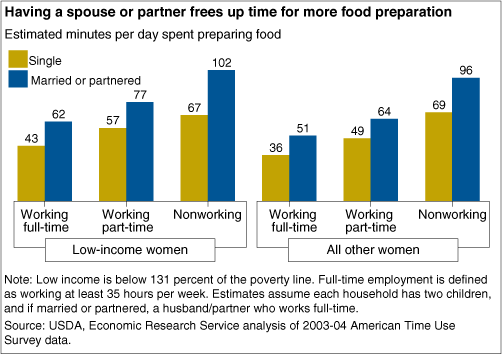Time Is Money. . .and Dinner!
- by Lisa Mancino and Constance Newman
- 9/3/2007
Our food choices are constrained by more than just income, prices, and individual preferences. Time available for preparing food is also a limited resource. Preparing food takes time—quite a bit for homemade lasagna and not so much for a microwaveable entree. ERS analysis of the 2003-04 American Time Use Survey indicates that, among women, time commitments are more important than income in determining the time spent preparing food.
As incomes rise, families are more likely to substitute money for time because they can more easily afford time-saving goods and services. Yet, the ease with which they make these substitutions may also depend on factors beyond income, such as time demands of work and children and the ability to divide household tasks among other members of the household.
Overall, women spend more than twice as much time preparing food than men do. And married or partnered women spend more time preparing food than do single women. In almost all cases (working or not, low income or not), having a partner or spouse has the largest effect, in absolute terms, on time allocated to preparing food. Married or partnered working women spend about 15 minutes more per day preparing food than do single working women, and married or partnered nonworking women spend approximately 30 minutes more per day preparing food than do nonworking single women. The presence of children also increases the amount of time allocated to preparing food.
Among all women, food preparation time falls as they spend more time working outside the home. However, there is evidence that low-income working women may be less able to substitute money for time than women with higher incomes. While higher income women who work full-time spend about 9 minutes less preparing food each day for every $100 increase in weekly earnings, time spent preparing food does not drop with earnings among low-income women.
These results suggest that, among women, time is at least as important as money when deciding how much time to spend preparing food. Policies and programs aimed at improving well-being, such as providing assistance to help families meet basic food needs, should account for both time and monetary resources. Because prepared food is generally more expensive, food assistance benefits that do not also account for time resources may not fully meet the needs of households that are low on both adult time and money.
This article is drawn from:
- Mancino, L. & Newman, C. (2007). Who Has Time To Cook? How Family Resources Influence Food Preparation. U.S. Department of Agriculture, Economic Research Service. ERR-40.


